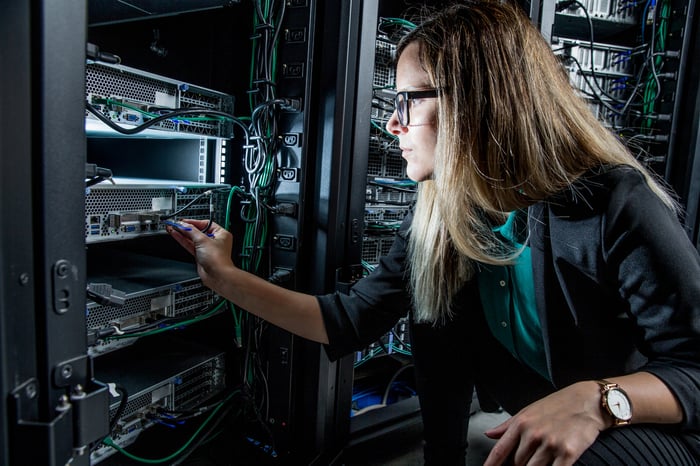For the past 30 years, investors haven't lacked for next-big-thing trends to latch onto. In 2023, absolutely nothing has captivated investors' attention more than artificial intelligence (AI).
In simple terms, AI utilizes software and systems to handle tasks that would normally be overseen or completed by humans. The key to the success of AI is the incorporation of machine learning, which allows software and systems to learn and become more efficient at their tasks over time. This ability to evolve gives AI-powered solutions application across virtually all sectors and industries.
As you might imagine, the dollar figures associated with AI are as grand as investors' expectations. A report from PwC pegs the added economic contribution from artificial intelligence at $15.7 trillion by 2030. This includes an estimated $6.6 trillion in increased productivity, as well as a $9.1 trillion consumption-side boost.

Image source: Getty Images.
While there are a number of companies that have benefited from the rise of AI, none stands out more than graphics processing unit (GPU) specialist Nvidia (NVDA 6.18%).
When Nvidia's fiscal 2024 began (Nvidia's fiscal year begins in early February), Wall Street expected the company to generate high-single-digit sales growth for the year. After just two quarters, analysts' consensus estimate now calls for 103% sales growth in 2024. We're talking about sales estimates being taken from shy of $30 billion to nearly $55 billion in about seven months. That's not pocket change.
Though Nvidia has enjoyed a modest rebound in its gaming segment, virtually all of this increase has to do with data center revenue. The company's A100 and H100 GPUs are dominating high-compute data centers. Since AI software and systems require split-second decision making, Nvidia looks to have cemented itself as the infrastructure backbone of the AI revolution.
Nvidia could be in for a rough calendar 2024
But in spite of Nvidia's overwhelming success, it has the potential to massively underperform next year for a very ironic reason: AI GPU production expansion.
The primary reason Nvidia's data center sales have soared is because production of its A100 and H100 GPUs is maxed out. A quick look at the company's fiscal second-quarter operating results shows that first-half cost of revenue (across all segments) actually declined from the prior-year period. What this tells investors is that AI-accelerated GPU scarcity and significant pricing power are what have collectively sent Nvidia's gross margin higher.
The proverbial monkey wrench for Nvidia is capacity at chip-fabrication giant Taiwan Semiconductor Manufacturing Company (TSM 1.26%) (commonly known as TSMC). TSMC's chip on wafer on substrate (CoWoS) capacity has been maxed out. Due to the ever-expanding memory needs of AI-accelerated data centers, high-bandwidth memory systems are typically packaged on CoWoS, leaving few cost-effective alternatives. In plainer English, Nvidia's hands are tied until TSMC can substantially increase its CoWoS capacity.
The good news is that TSMC expects to more or less double its CoWoS capacity sooner than later. Based on unofficial reports from online publication Tom's Hardware, TSMC aims to increase its CoWoS capacity from a current 8,000 wafers per month to 11,000 per month by year's end. Additional investments should increase capacity to between 14,500 and 16,600 wafers per month by the end of 2024.
The bad (perhaps even ironic) news is what happens when Nvidia can meet the needs of more of its customers.
As Nvidia's production expands, it'll face higher costs. This is not an unexpected outcome if a company is selling more of a particular good. But as its A100 and H100 GPUs become less scarce, the company's pricing power will decline, too. Nvidia's gross profit margin, which rocketed to 68.2% during the first half of fiscal 2024 from 55.7% in the comparable period in fiscal 2023, could go right back down as production ramps up.

Image source: Getty Images.
But wait -- there's more
While emphasizing volume could help Nvidia as its margins compress, it's not going to be the only show in town.
In June, Advanced Micro Devices (AMD 2.37%) unveiled the MI300X, which is its most advanced GPU for AI-accelerated data centers. Although AMD's rollout of the MI300X will only be for a handful of customers this year, it plans to really ramp up sales in 2024.
On top of AMD entering the playing field with a real competitor to Nvidia's A100 and H100 GPUs, Intel (INTC -9.20%) will be joining the scrum by mid-decade. Intel plans to release its Falcon Shores GPU in 2025 to compete directly with Nvidia in high-compute data centers. Both AMD and Intel have deep pockets and a rich history of innovative success.
In other words, competition entering the arena will put even more pressure on Nvidia's pricing power -- and therefore gross profit margin -- in 2024.
In addition, history may come back to bite Nvidia (and other AI stocks) after its phenomenal year.
Every single next-big-thing investment over the past 30 years has endured an initial period of euphoria that eventually popped. Whether it's the advent of the internet, business-to-business commerce, genome decoding, cancer immunotherapies, 3D printing, cannabis, blockchain technology, or the metaverse -- every one of these next-big-thing trends initially failed to live up to investors' lofty expectations.
Understand that I'm not saying businesses in these next-big-thing trends didn't, eventually, pan out. Rather, I'm pointing to the fact that every major innovation or growth trend has needed time to mature, and artificial intelligence is highly unlikely to be any different.
Investors are expecting perfection from Nvidia, as evidenced by its valuation. However, history has consistently shown that the ramp-up of next-big-thing investments rarely goes according to plan.





